Avia B-534
| Avia B-534 | |
|---|---|
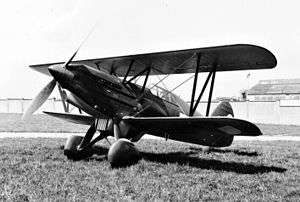 | |
| Avia B-534 fighter, late variant | |
| Role | Fighter aircraft |
| Manufacturer | Avia |
| Designer | František Novotný |
| First flight | 25 May 1933 |
| Introduction | 1935 |
| Status | Retired |
| Primary user | Czechoslovak Air Force |
| Number built | 568 [1] |
|
| |
The Avia B-534 is a Czechoslovak biplane produced during the period between the Great War and World War II.
Design and development
In 1932, the Czechoslovak aircraft company flew a first prototype of a single-engined fighter biplane, the Avia B-34, designed by František Novotný. After modification, the Czechoslovak Ministry of Defence placed an order for B-34s.[2] A second prototype, the Avia B-34/2, was built, which was intended to be powered by a 450 kilowatts (600 hp) Avia Rr 29 radial engine instead of the Hispano-Suiza 12N V12 engine of the first prototype and the initial production series. This engine proved prone to overheating and vibration, however, and it was decided to re-engine the B.34/2 before it flew, fitting it with a Hispano-Suiza 12Ybrs V12 engine.[3]
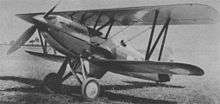
The Avia B-34/2 made its maiden flight on 25 May 1933. The prototype was sent for testing in September and was redesignated as B-534.1.[4] On 10 September, the B-534 was displayed to the public for the first time at an Army Air Day. It was to compete against the Praga E-44 and Letov Š-231.
A second prototype, the B-534/2 was completed in September 1933.[5] It differed from the first prototype in having an enclosed cockpit, a revised tail and undercarriage. On 14 April 1934 test pilot Václav Kočí successfully gained a Czechoslovak national speed record of 365.7 kilometres per hour (227.2 mph).[4]
More testing followed and an initial order for 34 aircraft for the Czechoslovak Air Force, soon increasing to 147, was placed on 17 July 1934.[6] At that time, the B-534 was well ahead of its contemporaries. The United Kingdom was still dependent on Hawker Furies, with the first Gloster Gladiators being produced at this time. The Soviet Union was placing its hope on its Polikarpov aircraft designs. The United States was still using descendants of the Curtiss Hawk series, with the Seversky P-35 and Curtiss P-36 just about to fly as prototypes.
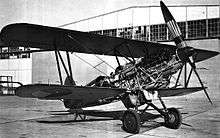
The B-534 was designed as a single-engine biplane fighter with a license-built Hispano-Suiza inline powerplant, and fixed landing gear. The air forces of the 1930s were reluctant to abandon the maneuverability and climb rates of biplanes for the speed of monoplanes, even in the face of new and better technology. The success of the Soviet pilots with biplanes may have contributed to this reluctance; they were known to strip their aircraft of sliding canopies, preferring to have the wind in their faces. Aircraft with two fabric-covered wings and fixed landing gear were also less expensive to manufacture.
First deliveries of the B-534 to the Czechoslovak air force began in October 1935, and 568 had been completed by 1939. The first 100 of these were of the first series. The second prototype was the blueprint for the I series, although it was built with an open cockpit. These early series aircraft were initially armed with four 7.92mm vz.28 guns. Two were located in the nose either side of the engine in a similar manner to the Avia B-34 and two were fitted in the wings. At an early stage of production it was however recognised that the wing mounted guns were troublesome. Aircraft from serial number B-534.47 were completed without the wing guns, which were also removed from the earlier aircraft. The first to fourth series aircraft were fitted with the Avia licence built version of the Hispano-Suiza 12Ydrs engine. This was a liquid-cooled V12-cylinder engine with a capacity of 36.05 litres. On the ground its normal power rating was 650 hp, it could deliver 750 hp for two minutes. At an operational height of 3,000 m (9,842 ft), it could deliver 850 hp for 30 minutes. At an operational height of 4,000 m (13,123 ft), it could reach 860 hp. Total fuel was 347 litres (76 gal) which was held in two fuselage fuel tanks of 90 and 257 litres.
The II series completed the remainder of the first order from the Czechoslovak Government, These were forty-five aircraft numbered B-534.102 to 147. Like the I series these carried four guns. However the solution to the problems with the wing mounted guns was to move these guns, now upgraded to the vz.30 to the fuselage with the others. The four 7.92 mm (0.312 in) machine guns were located in the sides of the fuselage, firing through the propeller.[7] One very modern innovation was a bubble canopy. This was tested on a small number of the early series aircraft, although certainly not a standard fit.
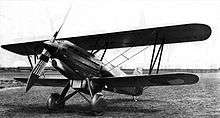
In 1936 a second order for 46 aircraft were issued by the government. The first 25 of these were the B-534/III version serial numbers B-534: 148–173. Production took place in the second half of 1936. It entered service between March and April 1937. The III series had aerodynamic refinements which saw the streamlining of the front carburator air intake. Mudguard spats were also often added at the factory to the main gear.
The remainder of the second order from 534.174 to 534.193 were the IV series. With later orders the fourth series would occupy the serial numbers .174 and 445 and was therefore the most numerous of the types. The most important change to the earlier series was the enclosed cockpit. The IV series also enjoyed a metal light alloy Letov (Hochfeld) Hd-43 propeller. The various refinements allowed the IV series to have an increased speed of over 200 mph, and this placed it on par with the best of its contemporary biplanes. A common alteration to the IV series was the replacement of the tail skid with a tail wheel. Operational experiences had shown that the spat on the main landing gear could become clogged with mud on grassy airfields and cause take-off and landing problems. The spats were then often removed.
The superb performance of the aircraft was demonstrated at a flying exhibition in 1937. The aircraft was tested against the best in the world at the IV International Air Meeting at Zurich's Dübendorf airport. The B-534 entered three of the competitions. The first of these tested climbing and diving. A GermanBf 109 took first place and a Henschel Hs 123 pilot pushed his biplane to claim second. The B-534 took the next three positions. The 534 outflew every other fighter participating, bar the Messerschmitt Bf 109 – and even then, the Avia was only 11 kph slower than the German aircraft.
The abrupt partition of Czechoslovakia in 1939 prevented the use of the B-534 in combat by the nation that had produced it. By then, high performance monoplanes such as the Bf 109 and Britain's leading models – the Hawker Hurricane and Supermarine Spitfire – were raising the bar of fighter/interceptor standards. Four sub-types were produced during the B-534's production run, all with mostly minor improvements.
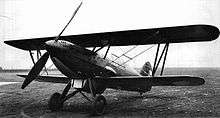
One major variation was introduced in this production run. The Bk-534 was designed to carry one 20 mm (0.79 in) Oerlikon FFS-20 cannon firing through the nose, and only two 7.92 mm (0.312 in) machine guns to the sides. Alleged problems with reconstruction to adapt to the new gun was not resolved in the summer of 1938, desperate to get more aircraft in the air, Avia decided to use a third machine gun in the nose. Judging by the size of gun magazine, the nose machine gun was fitted increased supply of ammunition.[8] Time was running out and drew to Munich Diktat, when the Germany occupies the Sudetenland, border parts of Czechoslovakia. Two series were produced Bk-534, cn's 501 - 554, and cn's 555 - 620. Only three of the second batch were completed for the Czech air force, and the remaining 63 aeroplanes from this production block was finished for the Germans, after German invasion of the remainder of Czechoslovakia 15.3.1939.
Operational history
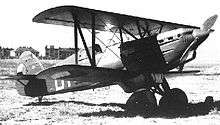
On 1 September 1938, less than a month before the Munich Agreement would cause Czechoslovakia to lose 30% of its territory and 34% of its population,[9] 328 B-534 and Bk-534s equipped 21 fighter squadrons of the Czechoslovak Air Force, with other aircraft being assigned to reserve and training squadrons, and deliveries continuing of the final batch of fighters.[10] On 14 March 1939, Germany forced the partition of Czechoslovakia, with Slovakia being declared as the nominally independent Slovak Republic with Germany annexing the remaining "Czech" part of Czechoslovakia as the Protectorate of Bohemia and Moravia the next day. The Slovenské vzdušné zbrane (Slovak Air Force) was organised out of the units of the Czechoslovak Air Force that were based in Slovakia at the time of partition, and inherited about 71 B-534s and Bk-534s.[9]
Slovakia quickly had to use its new formed air force, weakened by the departure of Czech pilots, to defend itself when Hungary invaded on 23 March 1939. Two B-534s were shot down by Hungarian anti-aircraft fire with four more being shot down by Hungarian Fiat CR-32 fighters and another Avia making a forced landing behind Hungarian lines, and being captured.[11]
In September 1939, Slovakia participated in the German Invasion of Poland, with the aim of regaining territories lost to Poland at Munich. Two squadrons of B-534s supported the attack, escorting Luftwaffe Junkers Ju 87 bombers on eight missions, losing two B-534s while claiming a single Polish RWD-8 liaison aircraft shot down.[12]
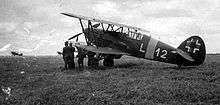
The same squadrons served with the Germans in Ukraine during summer 1941, with one squadron returning in 1942 for anti-partisan duty. Obsolescence, lack of spare parts and the old Czechoslovak air force’s proprietary fuel mixture (BiBoLi, or some other mix of ethanol, benzol and petrol) finally relegated the surviving B-534s to training duties.[13]
This would have been the last operational service of the B-534s in Slovak colors if not for the Slovak National Uprising of September–October 1944. The rest of the Slovak air assets did not turn-coat as expected and the leaders of the uprising were faced with using a rag-tag collection of leftover aircraft, including several B-534s at Tri Duby airfield. On 2 September 1944, Master Sergeant František Cyprich, just after testing a repaired B-534, downed a Junkers Ju 52 transport under Hungarian colors on its way to a base in occupied Poland. This was at once the first aerial victory for the Uprising and the last recorded biplane fighter air-to-air victory.[14] As the Slovak National Uprising was desperate for available aircraft, Sergeant Cyprich was derided by his colonel for not trying to force the Junkers Ju 52 to land and be captured instead. The last two B-534s at Tri Duby were burned as the base was evacuated on 25 October 1944.
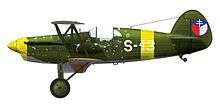
Bulgaria bought 78 B-534s in 1939, well after the partition. The last batch of these aircraft arrived in March 1942. On 1 August 1943, seven of these aircraft were able to make two passes at American Consolidated B-24 Liberator bombers returning from the raid on Ploieşti. Hits were scored but no B-24s were shot down and some of the B-534s that received damage in the combat, cracked up on landing. After the anti-German coup of 9 September 1944, Bulgaria switched sides overnight and its B-534s were often used in ground attacks against German units. On 10 September 1944, six B-534s were involved in a brief melee with six German Bf 109s at low altitude. One B-534 was lost, but the Germans quickly broke off, wary of the low altitude and the B-534's manoeuvrability.
Variants
- B-534/1: First prototype.
- B-534/2: Second prototype.
- B-534-I: First production version. (cn's 2 - 101)
- B-534-II: (cn's 102 - 147)
- B-534-III: (cn's 148 - 173)
- B-534-IV: Closed canopy (cn's 174 - 445)
- Bk-534: Cannon version (cn's 501 - 620)
Survivors
.jpg)
There are no real surviving airframes, but a B-534 replica is on display in the Prague Aviation Museum, Kbely, Czech Republic. A second replica, using (like the Kbely example) some original parts, is displayed at the Slovak Technical Museum at Košice International Airport, Slovakia.
Operators
 Bulgaria
Bulgaria- Bulgarian Air Force - The Bulgarian Air Force operated between 48[15] and 100 aircraft (though mostly the number 78[16] is named), which they called "Dogan" (Hunting Hawk).[17]
 NDH
NDH- Air Force of the Independent State of Croatia - An unknown number of Avia B-534 aircraft were supplied by the Germans.[15]
.svg.png) Germany
Germany- Luftwaffe - The German Luftwaffe used most of the airframes confiscated from the Czechs. These aircraft served through the early years of the war as trainers, night fighters, and glider tugs; three were used to test carrier landing operations for the aborted German aircraft carrier Graf Zeppelin.[18] The Germans had another use as well: B-534s also starred disguised as Polish fighters in a German propaganda film, "Kampfgeschwader Lützow".[19]
.svg.png) Greece
Greece- Hellenic Air Force - A Greek businessman bought two B-534s and presented them to the Greek government. They were lost in the chaos of 1941.[15][20]
.svg.png) Hungary
Hungary- Royal Hungarian Air Force - One B-534 was captured by the Hungarians during the border war in 1939 and tested for a period, carrying the code HA-VAB,[16][21] later serialled G.192.[22]
 Romania
Romania- Together with three DFS 230 gliders, Romania received an unknown number of Avia B-534 tugs according to one source.[16]
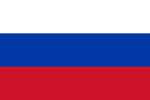 Slovakia
Slovakia- Slovenské vzdušné zbrane - The Slovak Air Force operated several B-534s from Czechoslovakia.[23][24]
 Soviet Union
Soviet Union- A number (eight is given in some sources) of B-534s were allegedly used by the Soviets in a secret NKVD squadron to shadow flights of German aircraft.[16]
Specifications (B-534 IV)

Data from Aircraft of the Third Reich Vol.1[25]
General characteristics
- Crew: 1
- Length: 8.1[26] m (26 ft 7 in)
- Wingspan: 9.4 m (30 ft 10 in)
- Height: 3.15[26] m (10 ft 4 in)
- Wing area: 23.56 m2 (253.6 sq ft)
- Empty weight: 1,460 kg (3,219 lb)
- Gross weight: 2,120 kg (4,674 lb)
- Max takeoff weight: 1,980[26] kg (4,365 lb)
- Powerplant: 1 × Hispano-Suiza 12Ydrs liquid-cooled V12 engine, 632.5[27] kW (848.2 hp)
Performance
- Maximum speed: 405 km/h (252 mph; 219 kn) at 4,400 m (14,436 ft) (standard 380 km/h ) [26]
- Cruising speed: 345 km/h (214 mph; 186 kn)
- Range: 600[26] km (373 mi; 324 nmi)
- Service ceiling: 10,600 m (34,777 ft)
- Rate of climb: 15.15[26] m/s (2,982 ft/min)
- Time to altitude: 5,000 m (16,404 ft) in 5 minutes 30 seconds [26]
- Wing loading: 84[26] kg/m2 (17 lb/sq ft)
- Power/mass: 0.319 kW/kg (0.197 hp/lb) [28]
Armament
- Guns: 4× 7.92 mm (0.312 in) vz. 30 (Česká zbrojovka Strakonice)[29] machine guns with 250-300 rpg
- Bombs: 6× 10 kg (22 lb) or 4x 20 kg (44 lb) bombs
See also
- Related development
- Aircraft of comparable role, configuration and era
- Blériot-SPAD S.510
- Fiat CR.32
- Fiat CR.42
- Grumman F3F
- Hawker Fury
- Heinkel He 51
- Kawasaki Ki-10
- Polikarpov I-15
- Related lists
References
Notes
- ↑ Aeroarchív - Avia B-534, Jiří Vraný, 1991, p. 3, ISBN 80-7030-114-7
- ↑ Air International July 1974, p. 26.
- ↑ Air International July 1974, pp. 26–27.
- 1 2 Air International July 1974, p. 27.
- ↑ Krybus 1967, p. 3.
- ↑ Air International July 1974, pp. 27–28.
- ↑ Bílý, Miroslav and Jiří Vraný. Avia B-534: Cz. Fighter, 3rd and 4th Version, 2008, pp. 42–44, ISBN 978-80-86524-15-3
- ↑ Avia B-534, Jiří Vraný, 1994, pp. 36–37, ISBN 80-901263-6-7
- 1 2 Rajlich and Sehnal 1994, p. 63.
- ↑ Air International July 1974, p. 33.
- ↑ Rajlich and Sehnal 1994, pp. 64–65.
- ↑ Rajlich and Sehnal 1994, p. 65.
- ↑ Chant 1999, p. 28.
- ↑ Rajlich, Jiri; Boshniakov, Stephen; Mandjukov, Petko (2004). "National Uprising". Slovakian and Bulgarian aces of World War 2. Oxford: Osprey Publishing. p. 58. ISBN 978 1 84176 652 2.
- 1 2 3 Krybus 1967, p. 10.
- 1 2 3 4 Vraný 1994, p. 45.
- ↑ Vrany 1994, pp. 34, 45–46.
- ↑ Vrany 1994, pp. 39, 44.
- ↑ Krybus 1967, p. 8.
- ↑ Vraný 1994, p. 46.
- ↑ Vraný 1991, backcover
- ↑ Kudlička 2006, backcover.
- ↑ Šumicrast 2003, pp. 2–51.
- ↑ Vraný 1994, pp. 46–49.
- ↑ Green 2010, pp. 93–96.
- 1 2 3 4 5 6 7 8 Avia B-534, Jiří Vraný, 1994, p. 60, ISBN 80-901263-6-7
- ↑ Avia B-534, Jiří Vraný, 1994, pp. 57-58, ISBN 80-901263-6-7
- ↑ Avia B-534, Jiří Vraný, 1994, ISBN 80-901263-6-7
- ↑ "7,92 mm letecký kulomet vz. 30". Československá armáda 1938. Retrieved 25 February 2014.
Bibliography
- Bílý, Miroslav and Jiří Vraný. Avia B-534: Czechoslovak Fighter, 3rd and 4th Version (Model File). Prague, Czech Republic: MBI, 2008. ISBN 80-86524-15-9. With 71 pages the most comprehensive detail publication about the B-534 to date.
- Chant, Chris.Aircraft of World War II. New York: Barnes & Noble, 1999. ISBN 0-7607-1261-1.
- Cieślak, Krzysztof. Samolot Mysliwski Avia B.534 (Typy Broni i Uzbrojenia 34) (in Polish). Warszawa, Poland: Wydawnictwo Ministerstwa Obrony Narodowej, 1975.
- Green, William. Aircraft of the Third Reich Vol.1 (1st ed.). London: Aerospace Publishing Limited, 2010. ISBN 978-1-900732-06-2.
- Green, William. War Planes of the Second World War, Fighters, Volume One. London: Macdonald & Co.(Publishers) Ltd., 1960. ISBN 0-356-01445-2.
- Krybus, Josef. The Avia B.534 (Aircraft in Profile number 152). Leatherhead, Surrey, UK: Profile Publications Ltd., 1967. ISBN B000-7K11J-M.
- Kudlička, Bohumil. Avia B.534 Czechoslovakian Fighter 1933-45. Prague, Czech Republic: CMK, 2006. ISBN 80-903778-0-7.
- "The Last Belligerent Biplane - The Avia B 534". Air International, Vol. 7, No. 1, July 1974, pp. 25–35.
- Rajlich, Jirí and Jirí Sehnal. "'Tatra Eagles' The Slovak Air Force in Combat 1942–1945. Air International, No. 56, Winter 1994. pp. 63–68.
- Šumicrast, Peter. "Avia B.34, B.534 a Bk.534, Slovenských Pilotov 1939-1944." HT model špeciál 905. Poprad, Slovakia: HT Model, 2003, ISSN 1335-3667.
- Titz, Zdenek. Czechoslovakian Air Force, 1918–1970. Reading, Berkshire, UK: Osprey Publications Ltd., 1971. ISBN 0-85045-021-7.
- Vraný, Jiří. Avia B.534 (in Czech). Prague, Czechoslovakia: AeroArchiv, 1991. ISBN 80-7030-114-7.
- Vraný, Jiří. Avia B.534. Prague, Czech Republic: MBI, 1994. ISBN 80-901263-6-7.
External links
| Wikimedia Commons has media related to Avia B-534. |
- Avia B.534 and Avia Bk.534 by Håkan Gustavsson
- "Avia B.534". Paul Tagliaferri The Great Planes, 3 June 2002. Retrieved: 5 July 2006.
- Avia B.534 Series II in Greek service